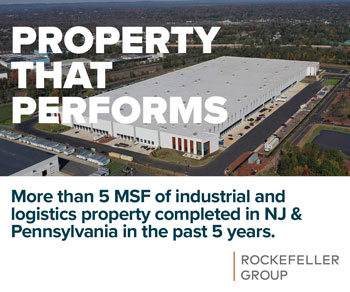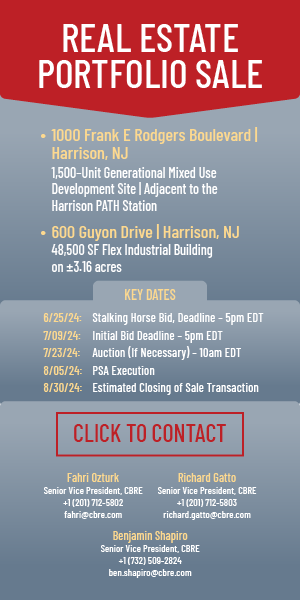Commercial real estate investors are increasingly focused on environmental, social and governance initiatives, or ESG, as they look to the future of their portfolios, partnerships and daily business operations.
By Joshua Burd
Jeff Milanaik is like many other developers, even those at the top of their field: Three to five years ago, so-called ESG initiatives — short for environmental, social and governance — were not on his mind when it came to Bridge Industrial’s fast-growing portfolio.
That changed when the firm set its sights on attracting new investors and an ambitious geographic expansion that even included opening an office in London.

“That exercise began to open us up to ESG,” said Milanaik, Bridge’s Northeast region partner, who described it as a growing priority for investors at home and abroad. “All of a sudden it was very much a part of our day-to-day conversation and we realized quickly that we didn’t know what we didn’t know and we need to research and find out: How do we navigate this?”
Milanaik and the Chicago-based firm did exactly that, joining a fast-growing segment of developers and service providers that are focusing on meeting ESG goals in their portfolios, partnerships and daily business operations. The veteran builder detailed those efforts during a Jan. 26 panel discussion hosted by NAIOP New Jersey, which highlighted how owners, investors and their professional teams can move toward a strategy that may be daunting but important to their company’s future.

“If it wasn’t on your radar already, it will be this evening,” NAIOP New Jersey CEO Michael McGuinness said during the chapter’s Annual Meeting and Real Estate Outlook event, which was held virtually. “ESG is a global business consideration of increasing importance to commercial real estate, because investors are evaluating these nonfinancial factors as they analyze risks and growth opportunities. And it’s not just investors.”
A recent report by CBRE highlighted the growing appetite for ESG investing, which touches everything from green building and energy efficiency to affordable housing and diversity, equity and inclusion programs at the corporate level. The firm said 60 percent of respondents to its 2021 Global Investor Intentions Survey said they’ve already adopted ESG criteria as part of their investment strategies, with a focus that is impacting every stage of the property lifecycle.
Milanaik and other panelists noted that, of the three legs of ESG, real estate owners are likely most conscious of their buildings’ environmental impact and the growing need to operate sustainably. That can translate to widely known, measurable data points such as energy and water usage, along with areas that are harder to benchmark such as waste and emissions.
In any case, gathering the information can be difficult for investors with large portfolios, especially those that are spread throughout the country. Kara Edmonson, a consultant and director of ESG with Verdani Partners, said that often requires compiling data from multiple utilities in multiple jurisdictions, which will likely have different standards and mandates for tracking water and energy usage.

“It is a continuing struggle to get the information in the first place to even figure out where you are, so that’s one of the things that we help our clients with a lot,” Edmonson said, noting that energy and water usage are easier to quantify, while “waste is the biggest challenge for everyone.” She added that the Energy Star rating system is a good starting point for owners of existing buildings, as is the U.S. Green Building Council’s widely used LEED scale, which stands for Leadership in Energy and Environmental Design, for developers.
Kerry Reef, director of real estate at Liberty Mutual Investments, said the company is now navigating that process in the early stages of integrating ESG into its platform.
“We’re now getting into that conversation of ‘How do we track it, what are we really tracking and how are we measuring it?’ ” he said. “And it’s challenging — I think in the homework and the diligence that we did, there was a wide variety of frameworks that people were following and tools that they were using to track this stuff.”
He added: “We’re in the stage of evaluating those and seeing which ones the industry is really starting to build transactions around, because … being able to look at your peers that are across the industry and being able to track it, I think, is what we’re all working toward.”

Reef said that, like the other legs of ESG, his team is evaluating the “social” component at both the partnership level and with each property or transaction. For instance, Liberty Mutual’s real estate group asks each partner to complete a due diligence questionnaire that solicits information on corporate responsibility, community involvement, employee engagement and diversity, equity and inclusion efforts, among other areas.
At the asset level, he said, the team looks at factors such as whether a residential property has access to good schools or transportation systems or whether tenants in a commercial property will have equal access to the building’s benefits. Edmonson added that achieving a higher “social” score can also come from providing opportunities for tenants to participate in the landlord’s sustainability goals.
Governance, on the other hand, can reflect the structures and systems that a company has in place to meet, sustain and report on its ESG objectives, she said. That includes a commitment to transparency about those efforts and having an outlet for stakeholders to raise issues or concerns about compliance.
“It’s the policies that you put in place in your organization to standardize your programs,” said Edmonson, whose firm has advised Bridge Industrial on its ESG initiatives. “It’s having the right leadership people in place to make sure that somebody is actually driving the program forward and checking in on how things go.”
Bridge Industrial has in fact taken such steps, Milanaik said, citing the importance of having an individual in the company who is dedicated to ESG.
“For those that are going to embark on this, I strongly would recommend that and find somebody that’s passionate about the topic in your organization, because they’ve become extremely successful at tracking down folks like myself and making us accountable,” he said.
Launching an ESG platform from scratch often starts with a sort of gap analysis to establish a baseline for the various goals, Edmonson said. There are different frameworks with which to do so, including the nonprofit Sustainability Accounting Standards Board, or SASB. It’s also important to do what’s known as a materiality or visioning survey, in which stakeholders identify which goals are important to them or of high impact to the organization.
Operators such as Liberty Mutual Investments also being practical as they incorporate ESG principals. Reef said that, at least in the early stages of its rollout, the company’s investments team decided that “it’s not going to be an exclusionary policy.”
“It’s not going to be the deciding factor in a single investment based on an ESG score or a due diligence questionnaire,” he said. “So it’s mixed in with all of the other risks and rewards that we’re evaluating on every single investment.”
The firm also uses its focus on ESG “to try to call out or identify both areas of risk or opportunity,” such as climate change, which it sees “as an elevated risk going forward. So there are various considerations we’re evaluating to make sure folks are thinking about that and we’re managing that from an exposure standpoint.”
Ultimately, Liberty Mutual and others hope that achieving ESG goals will also add value to their investments.
“That’s certainly something we’re looking into with each opportunity, whether it’s reducing operation costs, implementing a lot of the protocols we’re talking about or just increased tenant and capital demand on exit,” Reef said. “That’s how it’s really layered into our investment process. It’s more of a due diligence factor and a piece of the overall analysis.”










